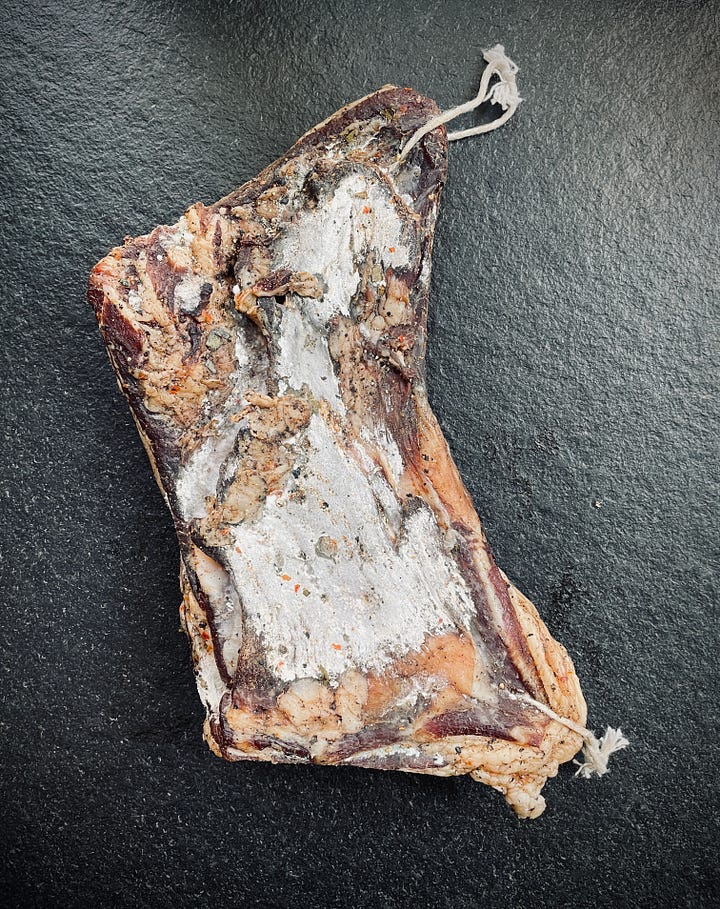Mouldy pig bits, a recipe for ricotta, and avoiding a run in with the Health inspector
On making charcuterie, ageing cheddar and trying not to die from botulism poisoning
There are skills I’ve taught myself in the last few years that I suppose I previously hadn’t thought to learn. Take charcuterie and cheese for instance. Natural products, made throughout the centuries by farmers, butchers and whole villages for festivals and for putting aside in the cellar after killing the pigs or to preserve that day’s milk; they’re still as relevant as they’ve always been, with little change in their method of production. As Chefs we put them on our menus and often use them with little thought, but do we really know how they’re made? To be able to create aged cheeses, cured sausages, hams and cuts of meat preserved and dried with salt and spices are old skills, a calculation of risk, a little luck and a lot of patience. I wanted to know how to create all the raw products that I would normally source, or at least have an understanding of how they’re made, so I set myself a project to start learning the techniques of curing and preserving meats and cheeses in the traditional way.
Charcuterie and Salumi
Over the last few years, I’ve successfully made fine venison bresaola, lamb breast pancetta, middle white coppa with aniseed, coppa with smoked chilli, saucisson-sec, fennel salumi, saucisson d’Auvergne, and possibly the best pancetta I’ve ever used. I’m not quite sure how this remarkable piece of pancetta came about as it was a first attempt, it must have been down to beginners’ luck, but the end result was quite unbelievable. I’d rubbed the belly piece with juniper, rosemary, black and red pepper, garlic, brown sugar and bay leaves and with the curing salts rubbed in, it was wrapped in the fridge for a few weeks, then hung to dry in the chamber for around four months next to the slowly maturing Coppa, allowing the fine penicillin mould cultures to transfer and keep the nasties away. I only wish I’d made more of that first batch.


I wanted to be able to create the raw products I use in dishes, rather than relying on sourcing ingredients. This isn’t to say I don’t buy products anymore, I do, but I felt that knowing how to be able to successfully create by myself the ingredients that I like to use was an important part of my skill set as a Chef. There aren’t many kitchens that make all of their own charcuterie, bacon and hams, but those that do have my utmost respect. The traditional skills that go into the production of dried hams and sausages are so important to use and pass on.
I was fortunate to have help and advice from Bill the Charcuterie Jedi. A year passed and batches of cured pig products had moulded and dried under my care. The input Bill gave me was invaluable, and I’m so very grateful to him for sharing his knowledge and allowing me to pester him.
Before this, many years ago, armed with a recipe from Fergus Henderson, Paul my trusty Sous and I had made a fine collection of fennel seed coppa, which we’d hung on a rusty metal fire escape underneath the front door of the swish Mayfair restaurant where I was Head Chef. Months of ageing passed, and we luckily had no visits from Environmental Health. I can imagine the shock of any inspector who might have found them swinging in the breeze, would most likely have resulted in a fine and a swift metaphorical kick in the balls. One of our commis chefs was told that if inspectors ever turned up unannounced, their first job was to run and cut down the offending articles and tidy them away in the walk-in. The tightly bound mummified, muslin and string-bound hams that hung on hooks in possibly the most inappropriate place in London to cure ham, had turned pleasantly solid and reasonably mouldy. The temperature and airflow were pretty constant as it was winter, and without the use of hygrometers and thermometers, it looked like we’d succeeded. I desperately wanted to put it on my lunch menu, but fearing the worst (as mouldy pig bits can obviously be a little hazardous), I had to be my own guinea pig. We unwrapped one of the huge fennel encrusted hams, scraped tentatively at the white and blue mould and put it on the gravity slicer. The result was slices of deep pink softly dried coppa that smelt exactly as they should. If I was going to serve it to my paying guests without harming anyone, avoid a brush with Environmental Health and most likely some kind of legal incident, it was down to me to taste it and see if I contracted botulism, that unfriendly neurotoxin that can occur if you make charcuterie badly. I ate a handful of slices and got on with my work for the rest of the day, conscious that any weird nerve twinges or sudden gripes in my belly and I’d be going straight to A&E. Forty-eight hours passed and I was happy that my foray into the world of charcuterie making had been a success. Pickles and remoulades were made, coppa was sliced and hedge fund managers and barristers ate their lunches. All in all, about ten kilos of coppa were sliced and sold over a few weeks.
Keep reading with a 7-day free trial
Subscribe to A Private Chef to keep reading this post and get 7 days of free access to the full post archives.

